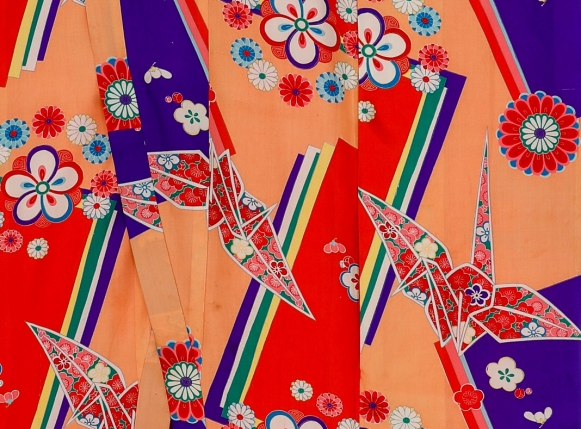Kazuko Nakano has been collecting children’s kimono since her young days, with nearly a thousand items in her collection by now, ranging from those dating back to the Edo period (1600–1868) to modern-day garments. Everyday attire, samurai kamishimo, and kimono from the time of World War II – all of these can be found in the collection, in children’s sizes of course. Ms Nakano’s passion for collecting has enabled me to take a close look at and gain insight into the world of these miniature works of art, and also to show them to an interested public through a series of exhibitions.
The diverse collection gives us a glimpse of the fashions, but also of the everyday life of ages past. What we find here is not just sophisticated festive attire worn on special occasions, but also everyday garments, worn out and patched up, with signs of recycling. There are also motifs from adults’ kimono which do not befit children’s clothing but have nonetheless been remade into it. These kimono do not represent the level of perfection usually attained in industrial manufacture. While their origin can probably be explained by economic reasons, I have the feeling that they carry tremendous cognitive value.
Made with the use of complicated techniques, the kimono take us into the world of symbols, fantastic creatures and myths that in most cases remain hidden from the Western eye in our time. They are genuine works of art, with a great variety of decorative motifs, and can be perceived as a kind of embroidered wish list with which the parents equip their children for their future lives. This deeply symbolic language refers us to desire for happiness, longevity, success, wealth, wisdom, ability, strength, persistence, and beauty.
Kazuko Nakano’s reflections on the exhibition
When I close my eyes, I look back on my childhood years.
Winter: Heat from my kimono insulated with cotton, which my mother warmed up every morning by the fire.
Spring: The rays of spring awaken lightness in awase (lined) garments.
Summer: The chill of outdoor clothing: hitoe (unlined) kimono made of chijimi, asa, or ro fabrics.
Autumn: The enjoyment of my long furisode on festive autumn days.
When I open my eyes, eighty years have passed like a dream.
Over the last seven decades, the kimono has gradually left my everyday life.
For the past thirty years, I have collected children’s kimono, which otherwise tended to disappear with time.
Five years ago, my last European exhibition (France, Switzerland, Austria, and the Netherlands) attracted the interest of Mrs Schmitt, and her passion for Japanese kimono rekindled mine with new strength. I decided to send 140 of my kimono on this long journey. During the preparations for the exhibition Mr and Mrs Schmitt were instrumental in putting in order and cataloguing nearly 1000 kimono which had never been on display in Central Europe before.
Ah, my little kimono can now be viewed in three Central European countries!
When I think about it, a thrill of excitement passes through my body.
What’s more, I recall my happy childhood, sunny mornings and evenings, and now, advanced in years as I am, I say goodbye to my little kimono and wish them a good journey.
Every meeting is unique.
Happy and satisfied, I look forward to another one.
